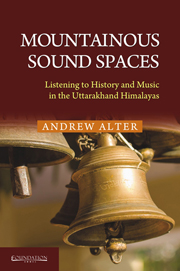Book contents
- Frontmatter
- Contents
- List of Figures
- List of Tables and Musical Examples
- Preface
- Acknowledgements
- Introduction
- 1 Echoes of Colonialism: Bagpipes in the Himalayas
- 2 Echoes of a Royal Heritage: Vestiges of Naubat
- 3 Possession and Performance: Sounding Out the Epic Worlds of Heroes and Gods
- 4 Worlds of Sound: Revisiting the Parameters of Oral Tradition
- 5 Flutes, Sprites and Mountainous Geographies
- 6 Drum Strokes, Syllables and Rhythmic Patterns
- 7 The Significance of Tantric Sects for Drum Practice in the Central Himalayas
- 8 Playing History: Sounding Out the Epic Worlds of Heroes and Gods
- 9 The Legacy of Garhwali Cassettes: Remembering the Pre-digital Age of Music Commodification
- Epilogue: Listening to an Uttarakhandi Himalayan Space
- Bibliography
- Index
9 - The Legacy of Garhwali Cassettes: Remembering the Pre-digital Age of Music Commodification
Published online by Cambridge University Press: 05 October 2014
- Frontmatter
- Contents
- List of Figures
- List of Tables and Musical Examples
- Preface
- Acknowledgements
- Introduction
- 1 Echoes of Colonialism: Bagpipes in the Himalayas
- 2 Echoes of a Royal Heritage: Vestiges of Naubat
- 3 Possession and Performance: Sounding Out the Epic Worlds of Heroes and Gods
- 4 Worlds of Sound: Revisiting the Parameters of Oral Tradition
- 5 Flutes, Sprites and Mountainous Geographies
- 6 Drum Strokes, Syllables and Rhythmic Patterns
- 7 The Significance of Tantric Sects for Drum Practice in the Central Himalayas
- 8 Playing History: Sounding Out the Epic Worlds of Heroes and Gods
- 9 The Legacy of Garhwali Cassettes: Remembering the Pre-digital Age of Music Commodification
- Epilogue: Listening to an Uttarakhandi Himalayan Space
- Bibliography
- Index
Summary
The invention of the analog audio cassette was a critical moment in the history of music industries worldwide. Introduced in the mid-1960s, the technology spread rapidly in the 1970s until it was the dominant format for music sales throughout the late 1980s and early 1990s before it was replaced by the compact disk. As Manuel (1993) has documented, cassette technology was adopted in India somewhat later than in the rest of the world, but once it arrived, it had an overwhelming impact on the consumption and production of popular music. Similarly, the replacement of cassettes by compact disks occurred later in India than elsewhere. In regional music traditions, the arrival of digital formats and music downloads via the internet has now created a complex new environment for sales quite unlike the uniformity of the cassette industry.
Manuel traces the boom in cassette production throughout India to the mid-1980s:
The years 1983-85 were the period of most dramatic expansion, when regional cottage cassette companies sprang up throughout the subcontinent, millions of rural consumers came to own indigenous or imported ‘two-in-ones,’ [radio-cassette players] and all manner of regional genres and subgenres started appearing on cassette. By 1991 regional-music cassettes were estimated to account for 40 to 60 percent of the entire recording market in India
(Manuel 1993: 156).Coincidentally the Garhwali film industry was also founded at this time. The first Garhwali language film, Jagwāl [The Vigil] was produced by Parasar Gaur in 1983. This was followed by three other Garhwali films during the decade: Kavī Sukh Kavī Dukh (1984), Ghar Jawaiṅ (1986) and Kauthīg (1987) (Uttarkhand Cinema). Meghā Ā was the first Kumauni film produced by S. S. Bisht in 1987 and this too contributed to a growing Uttarakhandi film industry. The two most popular Garhwali films were undoubtedly Ghar Jawaiṅ and Kauthīg, both of which featured the music and voice of Narendra Singh Negi.
- Type
- Chapter
- Information
- Mountainous Sound SpacesListening to History and Music in the Uttarakhand Himalayas, pp. 127 - 150Publisher: Foundation BooksPrint publication year: 2014



